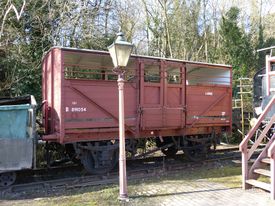BR 891054 Cattle Van
| BR 891054 Cattle Van | |
|---|---|
 BR Cattle Van 891054 | |
| Built By | Derby |
| Status | Operational |
| Number | B 891054 |
| Other Numbers | DB891054 |
| History | |
| Built | 1950 |
| Diagram | 1/350 |
| Lot | 2036 |
| Type | 4-wheeled non-ventilated van |
| Telegraphic code | OXFIT |
| TOPS code | VCV |
| Brakes | Vac fitted |
| 1991 | Arrived on SVR |
| 1992 | Restoration completed |
At one time there were more than 16,000 cattle wagons on the railways. BR continued to build them for several years after nationalisation. In 1962 it reduced the number of stations open for livestock from over two and a half thousand to just over two hundred. By the late 1960s only live cattle imported from Ireland were still being moved by rail until this too ended in 1975.[1]
After use as cattle vans ended they were put to other uses, for example some were cleaned out and covered with a tarpaulin for seasonal fruit or vegetable traffic[1].
Contents
Service
This 12 ton BR ‘Oxfit’ Cattle Van was one of a batch of 1,100 built at Derby and Shildon in 1949-50. It is something of a hybrid, with the body built to an LMS design but mounted on LNER running gear. It was equipped with steam heat through pipes for use with rural branch line passenger trains, to which these vans were often attached.[2]
891054 was one of a number of similar wagons later cut down for use as a tunnel inspection platform[3].
Preservation
891054 arrived on the SVR from Sheffield on 8 March 1991, having been acquired by the Highley Station Fund. It was restored at Bewdley over the winter of 1991-92. Copies of the LMS drawings were obtained to determine the design and profile of the missing roof. New steel roof hoops were rolled to the correct radius, approximately one foot was added to each upright, and the ends, roof and door hinges rebuilt around the resulting frame. New top doors were also made and the bottom doors and other body planks replaced as necessary. The door hinges and upright T-section steelwork were salvaged from a Fruit D van body on a farm near Pershore. After repairs to the vacuum brakes and repainting, the van was handed over to its owners at Highley.[3]
891054 is normally found at Highley where it was photographed adjacent to Highley signal box in March 2015. It was on display in the cattle dock at Arley station during the 2018 Autumn Steam Gala. It is thought to be the only surviving wagon of its type[4].

